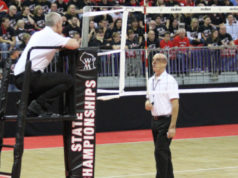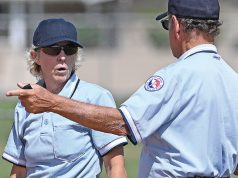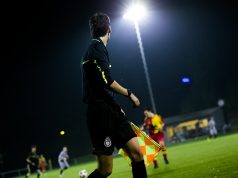A timeout provides officials with an opportunity to galvanize, regroup, clarify or simply maintain focus on the game at hand.
What can a person do in 60 seconds?
An Olympic-level swimmer can swim 100 meters. Nicolas Cage or Angelina Jolie can steal a car in the movies. Any of us can microwave one slice of bacon to perfection, and anyone willing to spend millions can air an ad during the Super Bowl.
And on game night, if we get 60 seconds, we can make the game better.
The timeout is certainly not the most exciting time for fans and viewers. It’s not a moment that anyone will remember after the game. But for officials, a normal timeout on the field or court can help us ensure that, regardless of the final score, the officials wind up winning.
In each sport, those brief opportunities for conversation vary. High school baseball and softball offers between-innings breaks of 60 seconds or five warmup pitches (whichever is shorter). NFHS football timeouts last 60 seconds, and high school basketball officials have either 60 or 30 seconds during a timeout. High school volleyball timeouts also last 60 seconds. College officials may have longer timeouts, depending on the level, including media timeouts, but most officials are limited to breaks shorter than a speed date.
If there’s a chance to talk, what do we say? How do we handle it?
First, let’s consider several reasons not to get together during a timeout. One, of course, is if the game is going smoothly. Why make the trip just to chat? Rich Fetter, who officiates NCAA basketball games from Division III through Division I throughout the Northeast, says that no meeting is sometimes the best meeting. “If we don’t need to get together, that means we’re on the same page,” he said. “If we’re shooting each other a thumbs-up, a wink here and there or a little smile, that’s all the better.”
Michael McGloon, veteran NCAA baseball umpire, agrees. “If things are going smoothly, I would recommend not getting together and talking,” he said. “I think it can be distracting.”
In some sports, logistics prevent full-crew meetings during timeouts. Jim Corpora, whose college football career features ACC championship games, bowl games and an FCS championship, says it doesn’t make sense to try to get the entire crew together in such a brief time window. “Frankly, it’s probably impossible to do that,” he said. “You’re spread all over the field. You almost have to run in and run back out, and you have other duties to perform.” Corpora says that a bizarre situation combined with a two-and-a-half minute college media timeout might make a full-crew meeting reasonable, but such situations are rare. He prefers quick meetings with one nearby official: the deep officials chatting, for instance, or the umpire and referee, but only if time allows and the situation merits it.
Joanne Venditto, CIF section representative from the Southern California Volleyball Officials Association, also suggests minimizing conferences. “You might do it once in a match at the most, so you have to pick your time,” she said. “If it’s something that you can communicate across the court — I might point to my eye to say, ‘Watch the centerline more.’ I try to communicate during the timeout with a silent signal.”
Time to Meet
So not meeting is preferable to meeting, especially when things are going well. But if there is something to say, and a timeout gives a crew an opportunity to say it, officials agree that conversation needs to happen.
“A crew should come together whenever necessary, whether it’s between innings or when a situation warrants a meeting,” said Tony Sullivan, whose softball career includes several NCAA conference tournaments, from Division I to Division III, as well as an Illinois state high school final. “The driver for any meeting should be a missing piece of information.” Communication can prevent a game from crossing the line from intense to ugly — but only if the communication is timely.
“Certainly I would tell my crew in a pregame meeting that if you see something, say something,” McGloon said. “I don’t want to find out after we’ve had something go down on the field that you noticed two innings earlier that guys were staring at each other from the dugouts.”
With that goal in mind, any official should be able to initiate a meeting. A partner who is afraid to talk may not share critical information. For that reason, Fetter said, “I think it’s the crew chief’s responsibility to see that the whole crew is comfortable with where we’re at. When the ball’s thrown up, we’re calling the same game. So I think it’s important that everyone has a voice because it’s going to be the crew that wins or loses at the end of the game.”
“The communication is key,” Fetter said. “I don’t want to come back to the locker room at halftime or the end of the game hearing something for the first time that would shock me. We want to make sure we leave everything on the floor.”
Where to Meet?
Imagine a common situation for high school officials: a crew of varying experience. The veteran partner in such a game is expected to serve a teaching role for the less-experienced partner, and both partners, if they have any sense of their own strengths and weaknesses. Should the partners wait to do their postgame discussion until the locker room, the local watering hole, or even the next association meeting?
Venditto doesn’t think so. “A strong partner in high school is often partnered with a weak partner,” she said. “When that occurs, during timeouts or between sets, the strong partner will definitely call the weaker partner over. They’ll want to help the partner with signals or with what he or she should be looking for, ‘R2, you watch the bottom of the net and I’m watching the top.’”
That conversation during a timeout has multiple positive impacts. Most importantly, it can improve the quality of the crew. As long as the experienced partner limits his or her suggestions for improvement to one or two areas — more than that can be overwhelming — it can create better coverage and calls for the remainder of that game. It also makes the game an educational experience for the lessexperienced partner, which will be good for everyone down the line. That also can create crew cohesion. Fetter points out that he doesn’t want a less-experienced partner to feel like he or she is stuck out on “rookie island” while the more experienced partners make all the calls. A quick, encouraging timeout meeting can prevent that.
“We’ve all been there (as a rookie),” Fetter said, “so I would say the words that I would want to hear, encouraging them. Give them positives, telling them to be strong, be confident. Be encouraging, have fun. Obviously we want to be professional, but the more you can have fun and engage them.”
Challenging plays and situations that do not result in controversy can provide opportunities for the crew to stay engaged and cohesive, but only if the officials take advantage of opportunities to discuss them. Those can include timeouts. At a timeout, for example, Corpora would want to discuss a recent complex play. While the whole crew need not discuss it, the deep officials can quickly review mechanics and responsibilities by discussing the play.
“For example, suppose on the previous punt the receiving team subbed in guys fairly late,” Corpora said. “I might say to (the other downfield official), ‘Hey, did you get 11 (players)? That’s what I had.’ Or a team throws some kind of a trick play at you that you weren’t aware of or weren’t expecting. I might say, ‘Man, I almost got caught on that, I almost got beat deep.’ Things like that.”
That brief timeout conversation serves to keep both officials engaged and in the game. It causes them to review their own responsibilities and coverage areas, and to ensure that they are working together well. It only takes up a few seconds of the timeout, but both officials leave better prepared to take on the next challenge thrown at them.
Late Game, Close Score
Once the officials have worked out the kinks early, the game progresses. When it gets late, and the outcome is still in doubt, emotions can run high among participants and fans. Is it a good idea to chat during those situations?
Most officials agree that the right kind of conversations between officials during timeouts late in a close game can be beneficial for the crew and for the participants.
“You can referee a game for 39 minutes, 30 seconds and all it takes is that one slip at the end of the game that everyone remembers,” Fetter said. “For a close game, it’s obviously really important to talk through timing, score. Are we getting close to some kind of bonus? Specific players, tendencies, the arrow, who’s got timeouts left. Make sure everyone’s on the same page and the focus is there so we can get through without any issues.”
Corpora agrees. He calls it “situational awareness,” and there is some aspect of that in every sport. In football, Corpora says, it might sound like an official saying to his partner, “Hey, this team has one timeout. They’re on defense and they’re losing, so if the play is inbounds, let’s make sure we look at a coach.”
Quick conversations like those can make a huge difference at crunch time, and a crew that neglects to have them because of some strict sense of decorum may be valuing crew appearance above the importance of critical calls at critical times. Officials should never go to the locker room wishing they had talked over the game situation that they wound up kicking at the worst possible moment.
Now, let’s move on to a pressure packed moment. Rightly or wrongly, a crewmember has made an unpopular call, and that’s the only thing on anyone’s mind, including the calling official. Timeout is called. The crew is faced with a complicated decision. Is it right to go talk to the official who made that call, in order to provide support and put the moment in the past? Or is it better not to talk to that official for fear of giving a wrong impression to the coaches and fans?
Most officials counsel against a big conversation at that moment. “I definitely would not recommend getting together immediately after there has been some controversy involving an umpire or an official,” McGloon said. “I think that just draws more attention to it.”
“In general, let the storm pass an inning or two before you initiate a meeting,” Sullivan said. Once that time has passed, Sullivan would not mince words with an experienced crew that had a rough stretch. “Get to the point and get it done quickly,” Sullivan said. He might tell his crew something like, “Guys, we were sloppy in the bottom of the second. We all know we’re better than that, so let’s work at getting back on point. Let’s set a goal of making them forget that half-inning with a well-officiated game the rest of the way.”
Corpora does not recommend coming together after a controversy, even during a timeout. When a crew comes together at such a time, observers are unlikely to interpret the conversation in a way friendly to the crew. Like it or not, Corpora said, “The message you’re sending is we’re not sure, or we’re trying to rationalize or justify. You can’t change it anyway at that point.”
Venditto agrees. “And if it’s controversial? No. You would not (come together),” she said. “Try to avoid it at all costs, because it makes the officials look weak. It just gives the spectators an opportunity to say, ‘Hey, get it right!’”
But a small gesture during a timeout, rather than a big production number, can help an official in the center of a storm to guide his or her craft to calmer waters to finish the game. While Corpora would not get his crew together, a quick act of kindness to a partner can help get him or her back in the game. He recalls a time when a partner “had just blown an inadvertent whistle. The guy just shut down,” Corpora said. “So the guy lived in a town called Worcester, Mass. I said, ‘Hey, how are things in Worcester? How cold is it?’ Anything to get the guy to react a little bit.
“Some guys, maybe you can try to bring back a little bit,” Corpora continued. “Other guys are going to shut down and that’s going to be it.”
Fetter points out that, in basketball, there might be a situation where a currently unpopular official is standing all by himself on one end of the floor while his or her partners are together at the other end. That might give an impression that the two officials are rejecting the third or even conspiring to say unkind things about their partner.
That may explain why Fetter goes against the majority on the question of officials getting together during a timeout after a controversial moment.
“Obviously emotions are high and tensions are high and adrenaline is running,” he said. “It may be important as a crew to go over and support him or her with that call, just getting that person and the crew to move past that because there’s the rest of the game to officiate. So I think the majority of the time it’s probably necessary to address it and get together as a crew.”
The net result: We must assess the risks and benefits of getting together after a controversial call. There’s a strong chance that coaches and spectators may read a post controversy timeout conversation negatively: as admitting a mistake or making one official appear weaker than the other. But if the possible negative is outweighed by the possibility of bringing a down, distracted official back into the game, a timeout conversation, even with just one partner, might be a good idea.
Ultimately, that’s the goal in any of the conversations: to maximize the quality of our officiating in that contest.
We want to use any tool at our disposal to attain that goal. That will include those precious seconds while the teams strategize: It might be a good idea for us to do that as well.
“If we have the opportunity to meet and we need to meet,” Fetter said, “let’s take advantage of that 30 or 60 seconds, however small it may be.”
What's Your Call? Leave a Comment:
Note: This article is archival in nature. Rules, interpretations, mechanics, philosophies and other information may or may not be correct for the current year.
This article is the copyright of ©Referee Enterprises, Inc., and may not be republished in whole or in part online, in print or in any capacity without expressed written permission from Referee. The article is made available for educational use by individuals.



















